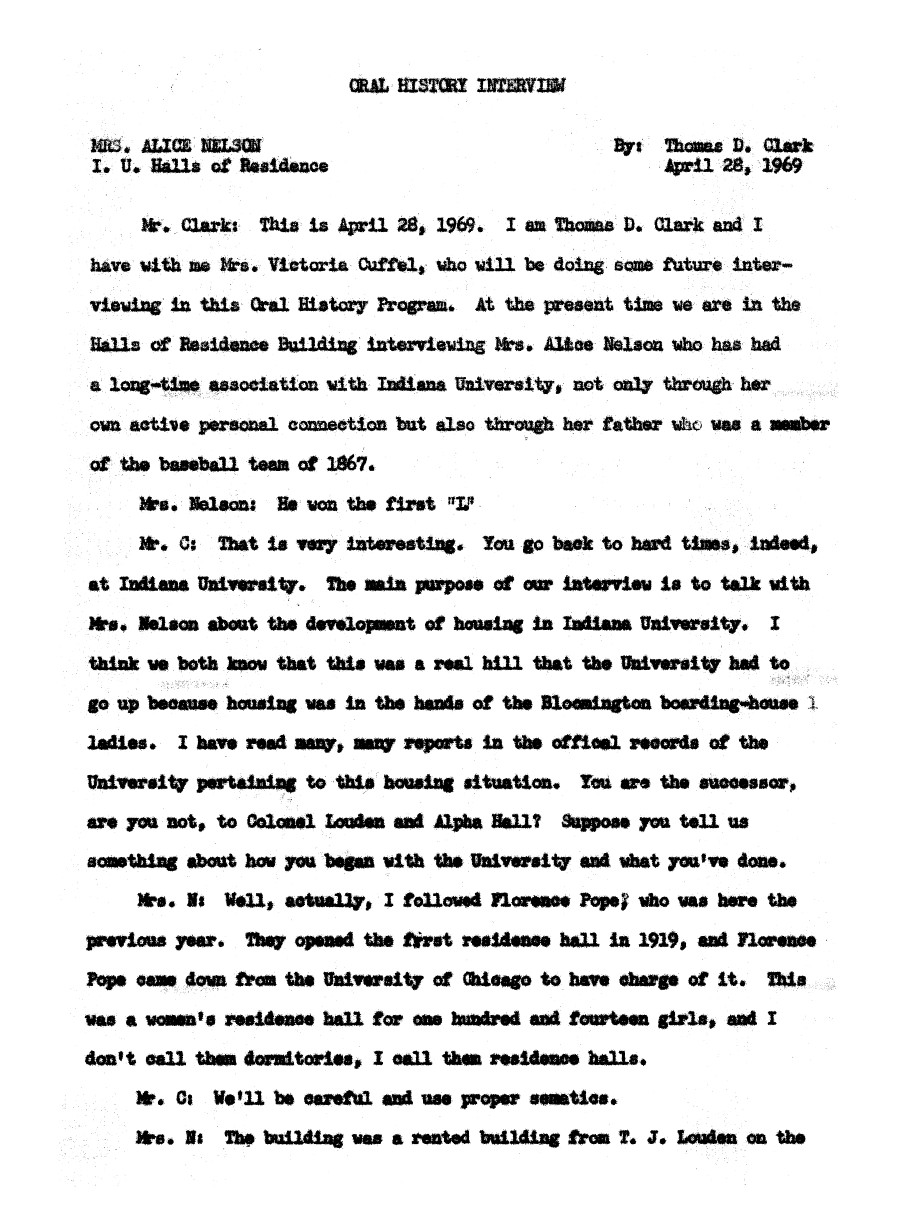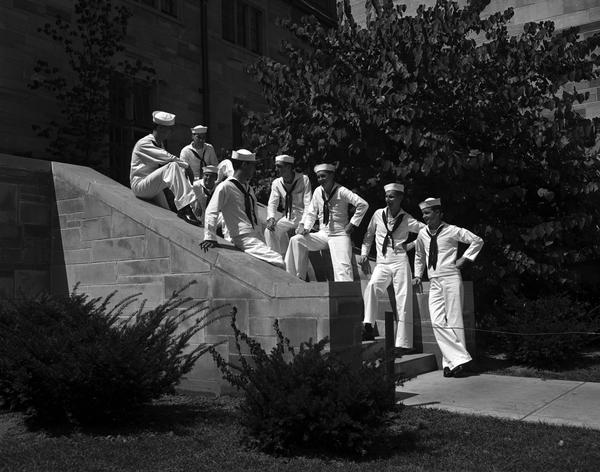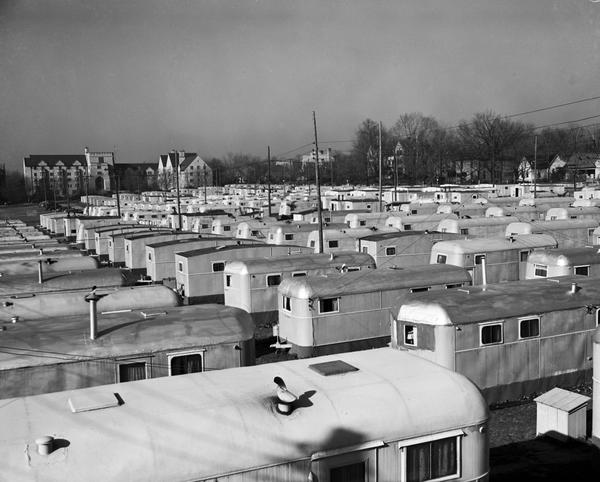Enrollment Growth in Veteran Populations
Rachel Condon (26 March 2017)
Indiana University and the Return of World War II Veterans

The main object that this project is based on is Alice Nelson’s August 17, 1973 interview chosen from a collection called the History of Indiana University held by the IU Center for the Study of History and Memory. Between 1968 and 1981 the project interviewed influential members of the Indiana University community. Nelson was a university administrator who oversaw a residential dorm during the post-war years. Her interview in particular shows the personal impact of returning veterans on an Indiana University community member.
The Servicemen’s Readjustment Act of 1944, known as the G.I. Bill, promised benefits for returning World War II veterans. One such benefit was free tuition to a state school, which many of young servicemen returning from Europe and the Pacific. The promise of a free education brought veterans to college campuses across America, but Indiana University in particular embraced this boom. Because of a desire to grow that laid dormant through the war years of the first half of the 1940s and a national patriotic sentiment following World War II, the Indiana University and Bloomington communities welcomed returning veterans who wished to continue their education and make use of the GI Bill.
Before the outbreak of World War II, university leadership had already expressed the desire to grow. Financer and IU alumnus Dwight J. Peterson became a trustee in 1937; by his account, the Great Depression left the Board of Trustees time to plan campus expansion. Soon after Peterson’s appointment, in 1938 Herman B. Wells was named President of Indiana University. He brought into office lofty ideas of transforming IU from a small-town school to a globally competitive university. By the end of the decade, the university planned to grow. Peterson said of the waning years of the Great Depression, “that window gave us opportunity to make plans to build Indiana University,” but he said of the halting of those plans, “When World War II came along, we were stopped again (Peterson, 18). The University and Wells would have to wait to fulfill their vision of being a globally renowned institution.
In the meantime, the IU and Bloomington communities supported the American war effort. The university became a training center for military personnel, and in July of 1942 Bloomington became home to a United States Naval Training School. The 1943-1944 school year saw IU graduating over 12,000 military personnel trained by the school (Warriner, 77-79). When interviewed about his time in Bloomington, former head of the Department of Journalism, John E. Stempel recalled that Bloomington was, like much of the nation, bolstered by patriotic sentiment and dutifulness. He tells the interviewer of a time Bloomington’s Crane Naval Ammunition Depot, an employer of 12,000 people, found themselves dangerously understaffed; 300 students gathered and walked to the plant and volunteered their help sorting parts for military canteens (Stempel, 16). The war brought jobs to Bloomington—jobs the patriotic population wanted to take to support their loved ones serving in the armed forces.

After the war ended, the GI Bill made the possibility of University expansion realistic again. A GI Bill was a veteran’s ticket to college; for any veteran eligible and interested it would fully fund the veteran’s tuition. Young men returning home, many of who spent their late teen years and early twenties overseas, enrolled in schools all over the nation. And they tended to perform well; they were widely regarded as serious students, more mature than their peers and sometimes with families to provide for (Greenberg, 39). They were encouraged to further their education for economic stimulation. More education meant better jobs, and the nation expected these returning vets to buy. Veterans went on spending sprees with houses, cars, and luxuries, and they would work to maintain that standard of living (Taylor, 103).
Veterans were welcomed into the Bloomington and IU communities because of the national attitude of patriotism and the benefits their presence brought. Interviewed in 1974, former director of IU’s Veterans’ Guidance Center and Assistant Dean of Students, Robert Shaffer, discussed how the administration handled the influx of veterans to the campus following World War II. He recalled that the IU community, administration in particular, was committed to accommodating the returned veterans. He says, “The political climate was such that to deny a veteran benefits was very bad in those days, almost impossible.” (Shaffer, 4). Alice Nelson, interviewed in 1969, remembered that during the housing shortage on campus she personally sacrificed greatly to house the veterans; she recalled getting little sleep during those years as someone was always in need of pillows and other necessities (Nelson, 5). As overseer of a residential dorm she saw the university’s size failing to meet the demands of its new population. Again committed to accommodating veterans, the university began building the physical infrastructure the growth made necessary and housed veterans unconventionally such as in academic buildings and Woodlawn Court, a campus field filled with trailers for veterans with families.

Indiana University wanted the veterans in order to expand and becoming a global leader in education, but Bloomington probably wanted the veterans for the financial stimulation they brought. Veterans were expected to “settle down” upon returning home. By purchasing houses, cars, and just living in the community, veterans could stimulate the economy of their chosen home and provide social stability (Saxe, 20). Communities like Bloomington craved the benefits WWII returning veterans could bring.
Indiana University and the Bloomington community already had plans for and were ready for growth by 1937, but the war would postpone the evolution of the campus. Promised a free education, returning veterans were an ideal group to usher in the changes the two communities desired. With their enrollment, Indiana University Bloomington was able to begin its transformation into a world-recognized institution of higher education.
Digital History Plan
To display digitally the attitudes of IU and Bloomington and the nation generally about veterans returning after WWII the project would utilize text coding. Each page of each interview would be scanned for comments revealing personal attitude and would be coded and marked in an excel sheet. For example, Alice Nelson was an administrator during the period and was both dutiful in her work to make the transition easier and apparently a bit resentful of the chaos it created. A single page of her interview might have three comments that fall under a “dutiful” attitude code while one might fall into “overwhelmed.” Each row of the spreadsheet would be a page of an interview, with columns for each code for the sentiments I have decided on. In Alice’s case, this row might have three marks in the dutiful column and one in the overwhelmed column. On a larger scale, a corpus linguistics tool might be of value in determining attitudes by showing the patterns of certain words being connected ( Michelle Moravec, 2013). If there were thousands of pages to code, corpus linguistics could cut the time requirement of the project. The project will use those codes, entered into an Excel file, to display a histogram showing the attitudes held by Americans about returning veterans after WWII. Ideally I would be able to look at every interview conducted, and have an assistant that would who would be able to code the interviews very specifically on sentiments I decided on. As it is, I cannot comb through every interview with the hope they mention something relating to my topic and; additionally, my classmates helped me code so I had to use less specific codes. With an assistant I could sit down and ensure higher inter-rater reliability. All interviews and more specific codes would give a better idea of the nuances of the community’s reaction. But using about twenty interviews in the collection with four fairly general codes gives a snapshot of overall sentiment in the community about the veterans’ return.
Digital History Project
I coded several of the project’s interviews to examine attitudes of feeling overwhelmed, responsible, generally positive, or generally negative about the influx of veterans to Indiana University. The results were entered into an excel sheet as explained above. However, I used line the spreadsheet to generate line graphs rather than a histogram. This allowed me to see the interactions of the sentiments, where they overlapped, and which ones tended to occur together. Below are line graphs charting the four attitudes for the interviews by Harrell, Peak, and Shaffer. For context, Charles Harrell was Registrar and Director of Admissions, Phillip Peak was Chairman of the Mathematics Department and Assistant Dean, and Robert Shaffer was Assistant Dean of Students and Director of Veterans’ Guidance Center.
Harrell:
Shaffer:
Peak:
The digital representation of these attitudes allows us to conclude that members of the IU community did not, for the most part, acknowledge their own responsibility to the school’s growth when making negative comments about veteran enrollment. They were eager, however, to discuss personal responsibility when positive comments about veterans were made. This suggests they had a great appreciation for the community, and valued their own role in its growth. On the other hand, they were hesitant to claim their role in their community when the showed disapproval of its growth.
Bibliography
Greenberg, Milton, The GI Bill: The Law That Changed America. New York: Lickle Publishing, 1997.
Moravec, Michelle, “Corpus Linguistics for Historians” in History in the City (Dec 2013; accessed February 23, 2015).
Nelson, Alice, interview by David Warriner. History of Indiana University, 1968-1981 Bloomington, IN, (August 17, 1969).
Peterson, Dwight J., interview by Victoria Cuffel and William B. Pickett. History of Indiana University, 1968-1981 Bloomington, IN, (June 9, 1969).
Saxe, Robert Francis. Settling Down: World War II Veterans’ Challenge to the Postwar Consensus. New York: Palgrave Macmillan, 2007.
Shaffer, Robert, interview by David Warriner. History of Indiana University, 1968-1981 Bloomington, IN, (July 17, 1974).
Stempel, John E. interview, interview by Vincent A., Jr. Giroux. History of Indiana, 1968-1981 Bloomington, IN, (November 19, 1979).
Taylor, Richard, and Taylor, Sandra Wright. Homeward Bound: American Veterans Return From War. Westport, Conn.: Praeger Security International, 2007.
Warriner, David Roland, The Veterans of World War II At Indiana University, 1944-1951. Thesis–Indiana University.